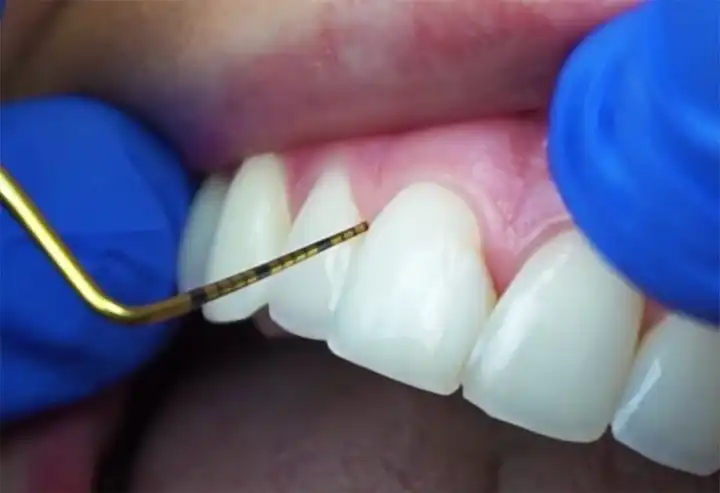Do Your Gums Grow Back? | Treatment & Prevention


If you struggle with receding gums and are starting to see the roots of your teeth in some parts of your mouth, you might be wondering “Do gums grow back” or “Will my gum tissues ever go back to where they were?” Being long in the tooth isn’t something you have to chalk up to getting older or inheriting from your parents. Understanding the delicate relationship of gum tissues, teeth, and gum recession can help you prevent receding gums from getting any worse (and take steps to correct it.)
Can Receding Gums Grow Back?
Long story short, no. It’s physically impossible to get receding gums to grow back up and over your tooth. However, we can get a little bit technical here and say that it is possible to get gums to reattach to teeth…at least to an extent.
Since gum tissues are attached to teeth via thousands of tiny little fibers (called the periodontal ligament) it’s key to prevent them from getting infected or traumatized. When they are, they automatically detach from the tooth and create a deep “pocket” underneath your gum tissues between them and the tooth. Pockets aren’t healthy, as they harbor bacteria that just complicates the cycle. As a side-effect, the tissue often begins to creep down the side of the tooth, revealing the root. In some cases, it is possible to establish a healthy enough pocket that the tissues inside of it will start to re-attach — to an extent — to the tooth root. But just because detached gums reattach to the root doesn’t mean the gumlines themselves will “grow back” to a higher level again.
How To Combat Your Receding Gumline
Early intervention and a modified oral hygiene plan are the best ways to combat gum recession. Since inadequate — or excessive — brushing and flossing are directly tied to gum levels, it’s important to understand what you might be doing — or not — to complicate your battle with receding gums.

1. Slow The Recession
Figure out what’s probably causing your receding tissues and then take steps to eliminate it. Brushing too hard? Lessen up. Not brushing enough? Time to get at it. Grinding your teeth? Consider sleeping in a night guard. Proper diagnosis is key.
2. Improve Your Home Care
Keeping your gumlines clean is crucial. If plaque is accumulating along the gums, it can cause them to detach and pull back. Additionally, scrubbing your teeth too hard could do the same thing. Pay close attention and brush thoroughly, but gently. Don’t forget to floss!
3. See A Dentist
Your dentist will examine your teeth, interview you, and make a diagnosis on the official cause of your gum recession. If it’s minimal, they might also recommend placing a tooth-colored white filling (bonding) over the exposed tooth root. Bonding is ideal for aesthetics and sensitivity issues, as long as the recession isn’t severe.
4. Consider Surgery
Traditionally, severe gum recession has always been treated with soft tissue grafting. This procedure involves relocating gingival tissues from one area or a donor to the place where your gums are receding. Grafting is still successful today, but there are less-invasive options such as “pinhole” that you may want to consider.
Common Causes
Usually there are about 5-6 factors you’ll want to consider when it comes down to identifying the main cause of your gum recession…
1) Gum Disease
2) Aggressive Brushing
Overzealous tooth brushing or using a stiff-bristled toothbrush can cause just as much recession as gum disease! Even though it may seem like harder cleaning is better cleaning, it’s actually counterproductive. It takes the right balance of thorough brushing and a quality soft toothbrush to do properly. Get your dental hygienist to show you how if you have any questions.
3) Poor Oral Hygiene
When there’s an excess amount of plaque or tartar along your gums, it’s natural for your gingival tissues to sort of creep back to get away from bacteria. Biofilm and tartar make it impossible for your gums to attach to your tooth. That’s why gum disease is the leading cause of tooth loss in adults.
4) Teeth Grinding
Excessive clenching and grinding (bruxism) cause tiny flexing movements near the gumlines. Over time, the enamel in that area will start to chip away and leave a notch or wedge that’s cut into your tooth. The gumlines usually pull back from those injuries. Even if you stop the grinding, it may not be possible to get the gums to re-cover that portion of tooth.
5) Genetics
You inherit your facial features and anatomical characteristics from your parents. If crooked or crowded teeth run in your family, you might notice those teeth showing signs of gum recession. It’s caused by the gums getting stretched or pulled around the tooth that’s out of alignment. Being aware of specific teeth that are misaligned will help you keep an eye out before recession starts.
6) Serious Tooth Or Gum Injury
Facial lacerations and trauma are common side-effects of athletic injuries, automobile accidents, or those accidental moments that happen around the house (like slipping in the bathroom.) Just like other parts of your body, injured gum tissue might scar over and not heal back correctly.
Preventing Receding Gums
Feeling stressed out? Invest in a night guard or bite splint. The small buffer between your upper and lower teeth will prevent them from completely grinding against one another, doing damage to the gums and enamel at the “necks” of your teeth.
Always be sure to schedule a routine dental exam and cleaning at least every six months. Your dentist or hygienist will evaluate your gumlines to see if there are any areas starting to recede, possibly before you’re even aware of them. Catching them early makes it easier to avoid unwanted complications or additional tissue loss.
And finally, if you have crooked or crowded teeth, talk to your dentist about getting braces or orthodontic aligners. Correcting the alignment of your teeth reduces the strain on your tissues, making it easier for them to stay attached where they’re supposed to.
Overcoming Gum Loss
Do gums grow back? No. That’s why it’s so important to understand the causes of gum recession and what steps you can take to prevent receding gums from getting any worse. With great home care and the help of your dentist, you can treat major issues like exposed tooth roots before other complications pop up. The key is great oral hygiene and an effective prevention plan!

Make your inbox smile!
Subscribe






